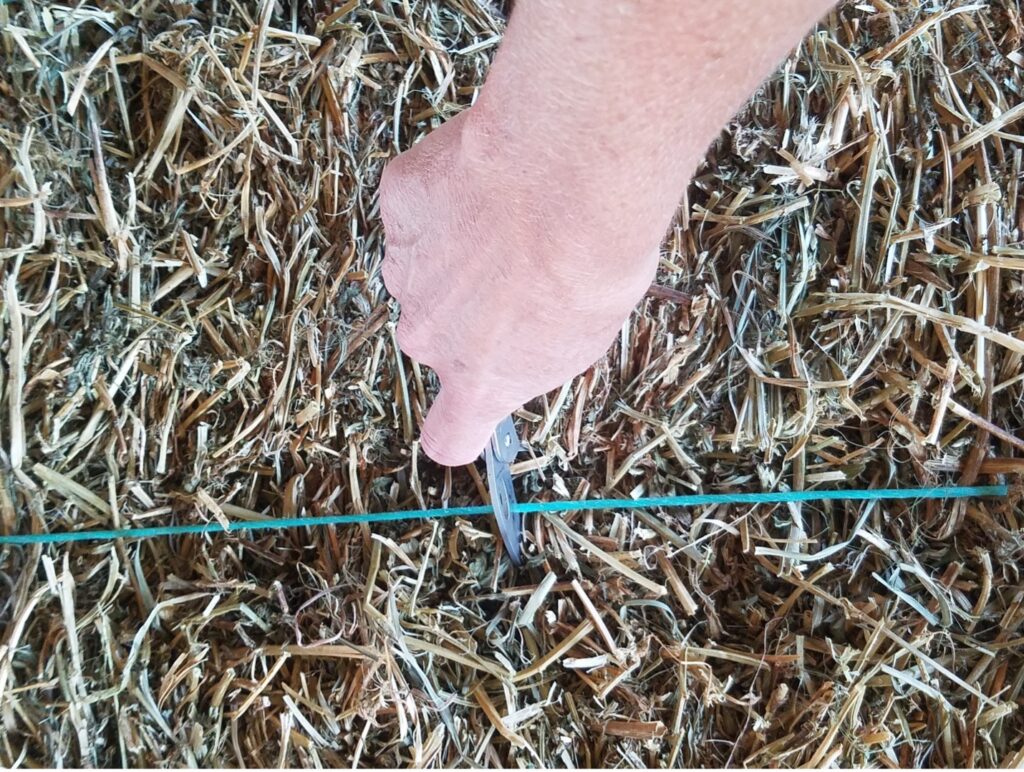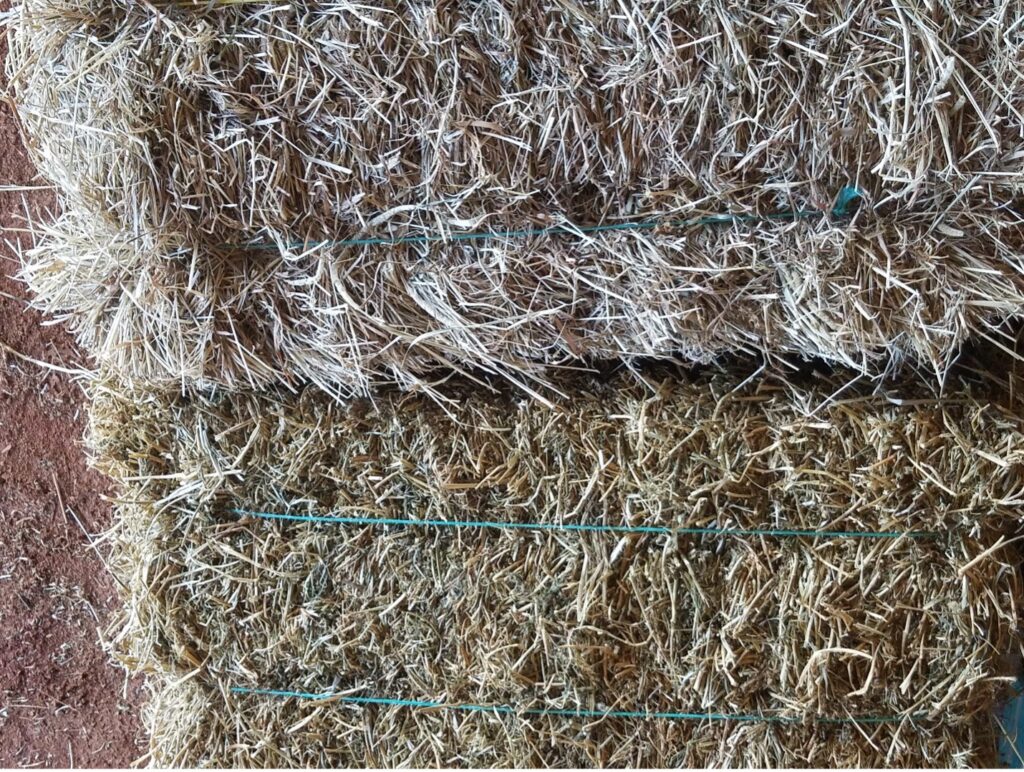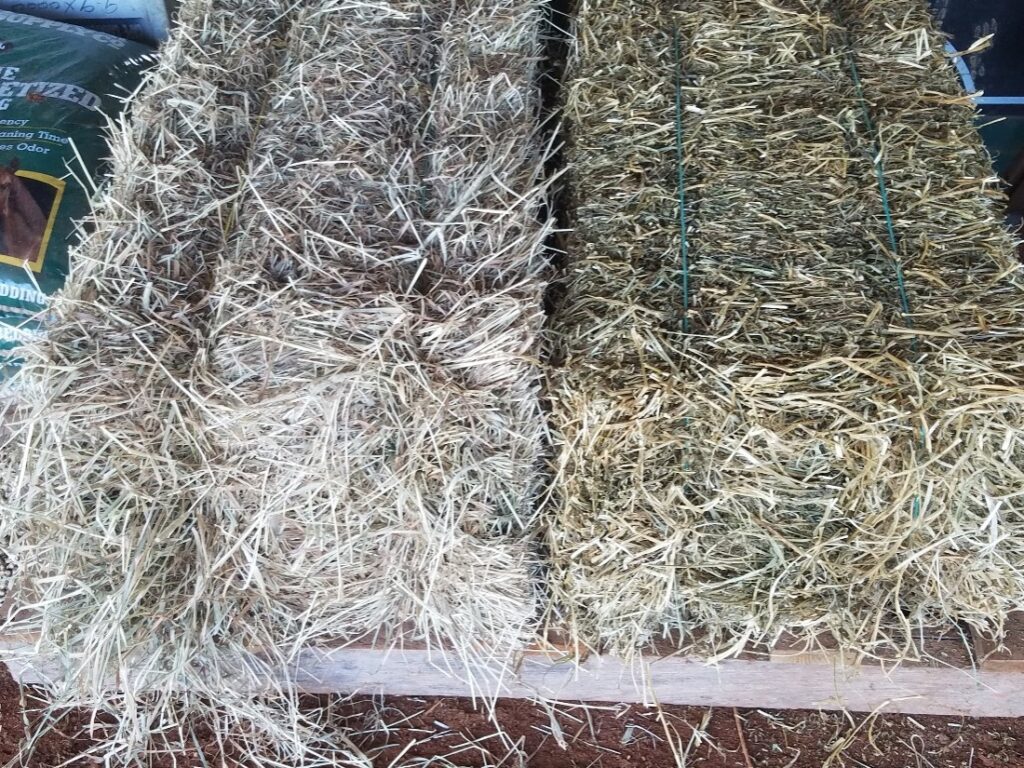By: Allison Bailey, ANR Agent, Wilkes County



Hay is the foundation of any horse’s diet. Most horses can get the majority of their nutrients from hay, with concentrates or supplements added as needed to complete the diet. Because horses are grazing animals, their digestive systems are designed to process forage almost continuously rather than in large meals like humans. Horses fed too little forage are more likely to develop stomach ulcers, digestive problems, and stress. Choosing the right hay is essential to maintaining your horse’s health and body condition, and there are many different factors to consider.
Hay quality can vary widely, and you can’t tell everything about it just by looking at a bale. Green hay may appear nutritious, but appearance does not always reflect nutrient value. Factors such as the type of plant, the stage of growth at the time of harvest, and nutrient composition all play a role.
Before we discuss these factors, I want to define a few standard terms that will appear throughout the remainder of this article, and when interpreting hay quality:
- Crude Protein (CP): An estimate of the protein level in hay as calculated from the nitrogen level in the forage. Protein is essential for growth, muscle, and milk production. Crude protein does not give you the quality of protein available to the animal.
- Neutral Detergent Fiber (NDF): Cell wall content (hemicellulose, cellulose, lignin). Higher NDF indicates reduced intake. NDF reflects how much hay horses will eat.
- Acid Detergent Fiber (ADF): The least digestible portion of fiber (cellulose and lignin). Higher ADF indicates reduced digestibility. ADF reflects forage digestibility.
- Total Digestible Nutrients (TDN): An estimate of the overall energy content of hay.
- Non-Structural Carbohydrates (NSC): This is a measure of sugars and starches in the forage that are likely to increase blood glucose and insulin levels. High NSC can be risky for horses with insulin dysregulation that predisposes them to laminitis, such as horses with equine metabolic syndrome (EMS) or Pituitary Pars Intermedia Dysfunction (PPID, “Cushing’s”).2
- Relative Forage Quality (RFQ): An index combining fiber digestibility and energy into a single number for comparing forages. Higher numbers indicate higher quality.4
1. Stage of Growth at Harvest
One factor influencing hay quality is the maturity of the plant at the time of cutting. Younger, leafy plants generally contain higher CP, lower ADF and NDF, and greater total digestible nutrients. This means they are often more suitable for horses with higher nutritional demands, such as growing foals, lactating mares, or performance horses.
As forage plants mature, stems become more fibrous and accumulate cellulose, hemicellulose, and lignin, which reduce digestibility and energy availability.1
- Grasses: Optimal harvest is at the boot to early head stage. By the time seed heads fully emerge, crude protein declines rapidly, while fiber fractions (ADF and NDF) increase.
- Legumes: Alfalfa and clover are most nutritious from early to mid-bloom. Protein and digestibility drop quickly after full bloom.
2. Type of Forage
Different forage species vary in nutrient content:
- Legumes (alfalfa, perennial peanut, lespedeza, clover): These are typically higher in protein (16–22%), energy, calcium, and other minerals as compared to grass hays. They are lower in fiber and more digestible, making them excellent for growing horses, lactating mares, or horses in heavy work. However, if fed alone (e.g., not mixed with grass hays), they may be too nutrient-dense (provide too many calories), especially for easy keepers or horses with metabolic disorders.
- Cool-Season Grasses (timothy, orchardgrass, tall fescue): These typically contain 10–16% CP depending on maturity and fertilization, and can be higher in energy and digestibility as compared to warm-season grasses, but they tend to accumulate more sugars, especially during cool, sunny weather or periods of drought stress. This can make them riskier for horses with insulin resistance, EMS, or laminitis. 2 Tall fescue is common in regions of the Southeast. Still, broodmares should only consume endophyte-free or novel fescue varieties to avoid foaling problems.
- Warm-Season Grasses (bermudagrass, bahiagrass): Warm-season grasses can be lower in protein (8–12%) and higher in fiber, making them less digestible than cool-season species. Well-managed bermudagrass hay can be a good maintenance hay for easy keepers or horses in light work. Bahiagrass is generally of lower quality and less commonly used by horse owners.
Many horse owners feed a mixture of grass and legume hay to balance the energy, protein, and fiber needs of the horse.
3. Visual Inspection
While forage tests give the most accurate information, visual inspection is an important part of hay selection:
- Smell: Fresh hay should smell sweet and free of musty or sour odors that can indicate the presence of mold.
- Texture: Leafy hay is better as leaves contain more nutrients than stems. Stemmy hay is typically lower in digestibility.
- Cleanliness: Hay should be free of weeds, dust, and foreign material.
- Discoloration: White, black, or other discoloration may indicate mold. Do not feed moldy hay to horses.
4. Laboratory Testing
A forage test is the only way to know exactly what nutrients a hay lot contains. Because hay quality varies even within the same cutting or field, it is recommended to core sample 10–20 bales per lot, mix the samples, and send that hay for analysis.
Key things to look for on a hay test:
- Moisture: 10–17% is safe for storage. Above 18–20% risks mold and heat damage. At ~25% or higher, microbial fermentation can generate enough heat to cause spontaneous combustion.
- Crude Protein (CP): Maintenance horses typically need 8–12% CP. Growing horses, broodmares, or performance horses may require 12–16% or more, which can be provided through the selection of a higher quality forage or by supplementation of a commercially balanced feed to complement a grass forage.
- Fiber (NDF & ADF):
- NSC (sugars and starches): Horses with metabolic issues should receive hay under 10–12% NSC. Soaking hay for 30–60 minutes reduces sugars by approximately 27%. 3
- RFQ (Relative Forage Quality):
- 100–130: Maintenance horses.
- 130+: Growing, lactating, or performance horses. 4
Other measures include calcium, phosphorus, and trace minerals, which are often deficient in Southeastern hays. Calcium to phosphorus ratio should not drop below 1:1. For more detailed information on the trace mineral needs of specific classes of horses, consult the online NRC database (https://webassets.nationalacademies.org/nrh/).
5. Matching Hay Quality to Horse Needs
| Horse Type | Crude Protein | NSC | Notes |
|---|---|---|---|
| Maintenance / Leisure | 10–12% | Any (unless metabolic) | Mid-quality grass hay works well |
| Performance/Growing/Lactating | 12–16% | Moderate | Early cut hay, legumes, or high-RFQ grasses ideal |
| Metabolic / “Easy Keeper” | 8–12% | <10% | Later-cut, fibrous hay; forage testing essential. It is important to still stay within upper limit guidelines for ADF and NDF to avoid digestive issues. |
Feeding hay that matches your horse’s needs helps prevent underfeeding, overfeeding, and the unnecessary expense of supplements. Here is a summary of what we’ve discussed:
Hay Selection Checklist
- Smell & Look
- Should smell fresh and sweet (not musty or sour).
- Green and leafy is best (leaves = nutrients).
- Avoid mold, dust, weeds, or foreign material.
- Texture
- Softer, flexible stems preferred.
- Avoid hay that is overly stemmy or brittle.
- Moisture
- 10–17% = safe for storage.
- Above 18–20% = risk of mold and heat damage.
- Over 25% = fire hazard.
- Nutrient Quality (Forage Test Recommended)
- Crude Protein (CP): 8–12% for most horses; 12–16%+ for growing, lactating, or performance horses.
- Fiber (ADF & NDF): ADF <35% = good digestibility; NDF <65% = good intake.
- NSC (sugars/starches): <10–12% for metabolic horses (EMS, laminitis, PPID).
- RFQ (Relative Forage Quality):
- 100–130 = maintenance horses
- 130+ = growing, lactating, or performance horses
- Match Hay to Horse Needs
- Easy Keepers / Metabolic Horses: Low NSC, moderate protein, higher fiber (e.g., well-managed bermudagrass)
- Maintenance Horses: Mid-quality grass hay (10–12% CP).
- Performance / Growing / Lactating Horses: Higher protein and energy (12–16%+ CP; legumes or early-cut grasses)
For further questions and information on performing a forage test in your area, call your County Extension Agent at 1-800-ASK-UGA1.
Footnotes
- Ball, D. M., Hoveland, C. S., & Lacefield, G. D. (2007). Southern Forages (4th ed.). International Plant Nutrition Institute.
- Johnson, P. J., Messer, N. T., & Ganjam, V. K. (2004). Cushing’s syndromes, insulin resistance, and endocrinopathic laminitis. Veterinary Clinics: Equine Practice, 20(3), 627–642.
- Longland, A. C., Barfoot, C., & Harris, P. A. (2011). Effects of soaking on the water-soluble carbohydrate content of hay. Veterinary Record, 168(23), 618.
- University of Georgia Cooperative Extension. (2021). RFQ Categorization of Forages. https://georgiaforages.caes.uga.edu/content/dam/caes-subsite/forages/docs/faqs/RFQ-categorization.pdf
